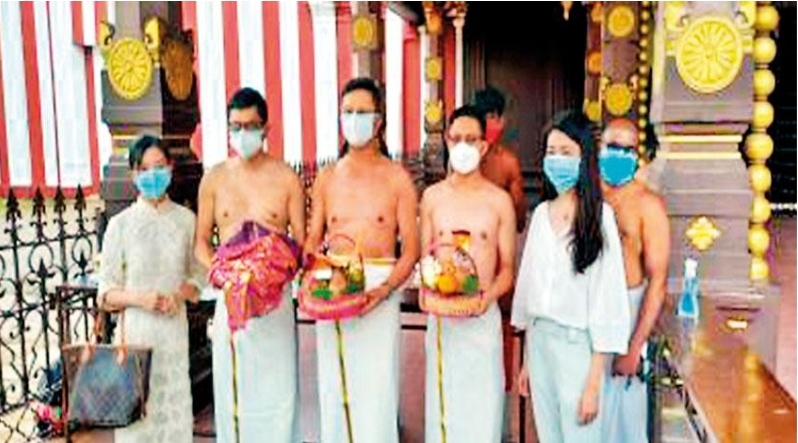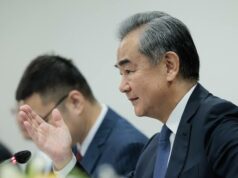Jaffna Is Too Far From Beijing

Chinese envoy and other embassy officials in traditional Tamil Hindu costume standing in front of the Nallur Temple in Jaffna
By
S M Ayub
The war between the Armed forces and the Liberation Tigers of Tamil Eelam (LTTE) played a decisive role for over three decades in shaping the current Sri Lankan Tamil psyche. The roles played by Beijing and New Delhi in respect of that war has ruled that the former cannot replace the latter in the hearts of Tamils
China has not shown any interest in political, economic or social activities in the northern and eastern regions of the island in the past while its political and economic arch rival in the region, India has been playing a major role in those activities there
The visit by Chinese Ambassador Qi Zhenhong to Nallur Kandaswamy Temple on December 16 and that of Prime Minister Mahinda Rajapaksa to Tirumala Venkateswara Temple in Tirupati, in Southern Indian State of Andra Pradesh on December 24 did not weigh equally on the scale, despite both temples being Hindu and very famous among people of others faiths as well.
One visit was of mere faith relevance while the other being seemingly public diplomacy. One was in the interest of one’s self salvation while the other in the interest of his country’s business.
However, it would be easy for one to perceive at least somewhat the nature of the diplomacy involved in the Ambassador’s visit, by looking at two photographs that had been taken during the visit to North and gone viral due to their symbolical significance – the picture of the Ambassador and his delegation entering the Nallur Temple attired in pure Tamil traditional costumes (veshtis) and bare-chested and the one where a drone operated by a Chinese official was seen in the background of the Chinese delegation in Point Pedro, the northern most tip of Sri Lanka.
China has not shown any interest in political, economic or social activities in the northern and eastern regions of the island in the past while its political and economic arch rival in the region, India has been playing a major role in those activities there. Interestingly, China had to withdraw recently from the only major economic project it had shown interest in, in northern Sri Lanka – three hybrid renewable energy projects in three islands off the northern coast of the country, apparently due to opposition on the part of India and the local Tamil leaders.
However, the Ambassador’s visit to the Jaffna Peninsula this month was an indication that China has not abandoned its interests in the Tamil dominated north despite its unsuccessful bid to secure those projects. The public diplomacy segment of the visit underscores it further. He, during the tour had visited the Jaffna public library, a major cultural centre in the north and had donated several laptops to it. Also, he had expressed his country’s keenness in developing fisheries industry in the region, a sector that has been hit hard by the long drawn civil war that ended twelve years ago and by the highhanded activities of Indian poachers. Fisheries Minister Douglas Devananda while talking to media in Kilinochchi recently had told that China was in competition with India to win a project for the development of fisheries harbour and surrounding areas in Point Pedro.
China might be feeling that this kind of diplomacy is sine qua non in order to bolster its future interests in the Tamil dominated region, in the light of the mass protests that swept Gwadar, the Chinese-dominated Pakistani port city which is at the core of the China-Pakistan Economic Corridor (CPEC), in the past several months. The CPSC is considered the crown jewel of China’s Belt and Road Initiative (BRI). One can even argue that the northern Sri Lanka is more susceptible to such anti-China protests given the political, cultural and psychological proximity between the Tamil people and India. Already Tamil leaders have expressed their aversion to China’s newfound love towards their compatriots. Almost all articles on the Ambassador’s visit in Tamil media had negative views.
Some analysts had been of the view that some of the items on the Ambassador’s itinerary for the tour was ill-planned and even provocative of India and it amounts to challenging a person while being in another man’s garden. In fact, the purpose of the Ambassador’s boat ride up to a point very close to the maritime border of India is something incomprehensible. He had even questioned the distance to India across the Palk Strait. Sri Lanka’s former Permanent Representative to United Nations in Geneva Dr. Dayan Jayatilleka had criticized the Sri Lankan government for allowing the Chinese envoy to resort to such a trip, disregarding India’s sensitivities.
Winning hearts and minds of Tamil people in Sri Lanka seems to be a gigantic task for Chinese.
China has a long way to go in that direction, given certain historical, cultural, political and even psychological realities involving Sri Lankan Tamil people. India is the second homeland to many Tamils in Sri Lanka owing to the geographical and linguistic proximity between the northern Sri Lanka and the southernmost State of India. The Mahathma Gandhi statues in many Tamil dominated areas in Sri Lanka attest to it. The Tamil Nadu media, especially the electronic media, more importantly the television channels owned by the Tamil Nadu politicians make a tremendous psychological and political impact on Sri Lankan Tamils. During the Sino-Indian war in 1960s and the three wars between India and Pakistan Sri Lankan Tamils and Tamil media clearly sided with India.
The war between the Armed forces and the Liberation Tigers of Tamil Eelam (LTTE) played a decisive role for over three decades in shaping the current Sri Lankan Tamil psyche. The roles played by Beijing and New Delhi in respect of that war has ruled that the former cannot replace the latter in the hearts of Tamils. Despite India having supported the government’s war efforts in a subtle manner, it always stood for the rights of Tamils in the island. And what the Tamils have achieved for the past seven decades in their search for a political solution to the national question was only the provincial council system of 1987, a result of much arm-twisting by India against the Sri Lankan government. Tamil leaders, still bank on India’s diplomacy in their quest for greater devolution of power, in spite of India’s stance towards her southern neighbour having mellowed and changed following the end of the Cold War in 1990s.
Although the livelihood practically topped the priority list of Tamils after the end of the war, Tamil leaders and media have replaced it with the political solution and human rights. Again Beijing and New Delhi took diametrically opposite sides when the Sri Lankan government was accused of human rights violations during the war at the UN Human Rights Council in Geneva.
Tamil leaders have been campaigning for an investigation against the Sri Lankan leaders by the International Criminal Court (ICC). However, it is no secret for them that it is an unachievable target in the light of the process having to go through the UN Security Council where China has the veto power. All in all, Jaffna is too far from Beijing.
SOURCE: Daily Mirror



